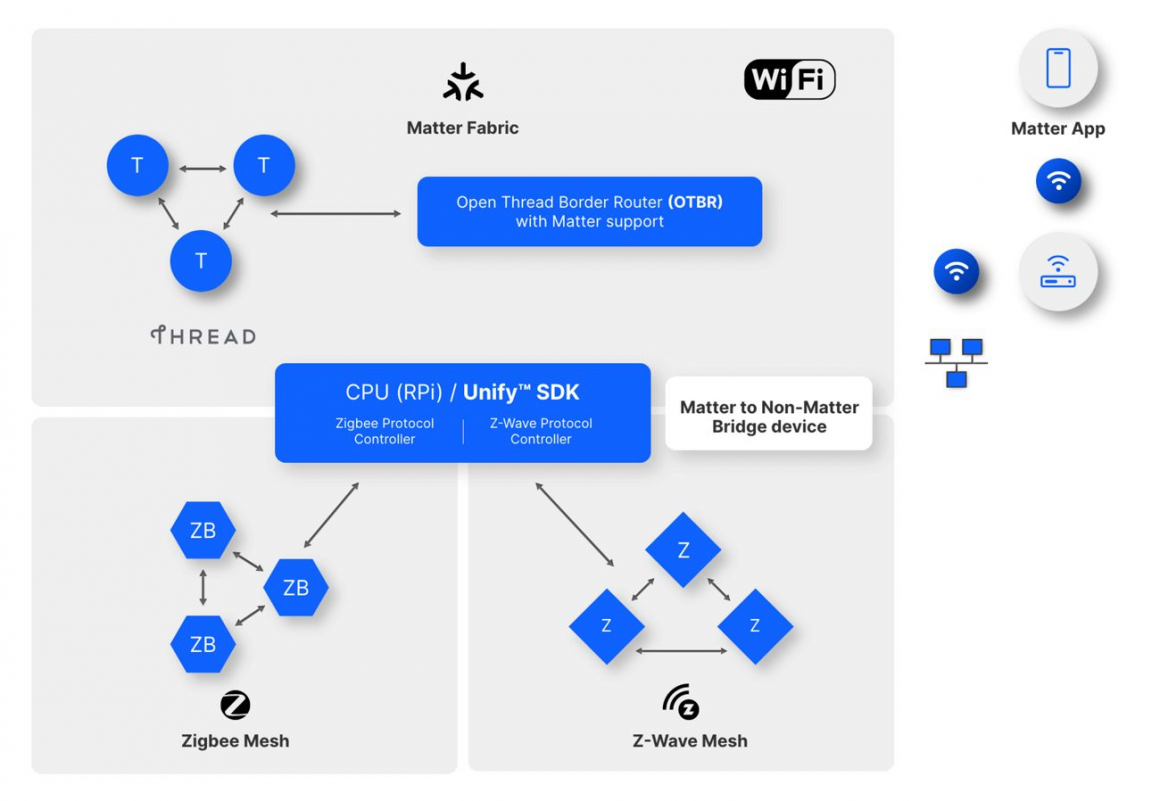Bridging Smart Home Devices to a Matter Network
A new Matter device can be controlled and be part of multiple ecosystems at the same time. Matter enables device manufacturers to build devices that are compatible with smart home and voice services such as Amazon Alexa, Apple Siri, Google Assistant, and others. For example, a light bulb can connect to both Amazon Alexa, Google Home, and Apple HomeKit. This means consumers will be able to add new products and brands to their smart homes without additional effort trying to figure out if X works with Y. With Matter, it just works.
The initiative was launched by some of the most influential names in the smart home ecosystem, including Amazon, Apple, Google, Comcast, and the Zigbee Alliance. Together, along with Silicon Labs and others, this group comprises the Connectivity Standards Alliance (CSA). Silicon Labs is a member of the Connectivity Standards Alliance (CSA) and has in-depth expertise in the underlying Matter IoT wireless protocols including Bluetooth, Thread, and Wi-Fi. Silicon Labs is also one of the largest code contributors in the CSA alongside Amazon Alexa, Apple HomeKit, and Google.
The Significance of the Matter Standard and Thread Protocol
Existing wireless protocols offer different benefits, such as low power operation for Thread, Zigbee and Z-Wave, longer range like Z-Wave Long Range and Wi-SUN, or high bandwidth such as in Wi-Fi. Matter allows these different technologies to share the same application layer and create seamless communication with the cloud.
Matter uses Bluetooth Low Energy (LE) for commissioning and runs over Wi-Fi, Ethernet, and Thread protocols. Before going into the Matter standard, it's important to have an understanding of Thread, an underlying network protocol to Matter.
Thread is a wireless networking technology, built from the ground up to be based on the familiar Internet Protocol (IPv6) and the proven IEEE 802.15.4 radio technology, intended to be secure and future-proof. The need to unify IPv6 and 802.15.4 technologies was resolved by the development of a layer that provides smooth adaptation between the IPv6 networking layer requirements and 802.15.4 link layer capabilities. This layer is called 6LoWPAN. The diagram below shows an overview of the Thread Stack and Matter as a unified application layer.
A Thread border router connects a Thread network to other IP based networks, such as Wi-Fi or Ethernet. The border router provides services for devices within the Thread network, including routing services for off-network operations, bidirectional connectivity over IPv6 infrastructure links, and service registry to enable DNS-based service discovery.
Silicon Labs provides the solution to build an Open Thread Border Router (OTBR) containing Raspberry Pi device and an example radio co-processor (RCP) application required to build border router software.
With security as a core tenet of the Matter standard, its architecture applies best practices to make the IoT more secure. Every device joining the network is authenticated before obtaining network credentials and every message is encrypted and authenticated. Use of proven and standard cryptographic algorithms and secure over-the-air (OTA) updates provides highest level of security.
Bridging Non-Matter Devices to a Matter Network
With a large install base of non-IP based Zigbee, Z-Wave, and other wireless IoT protocols, bridges will be a key aspect of connecting Matter to these devices to integrate the technologies. Although some end devices could meet the requirements (such as sufficient flash and RAM) to be upgraded in-field, it will be simpler, more stable, and a better user experience to bridge existing sensor networks to interoperate with Matter networks. Many IoT companies, including Silicon Labs, will be introducing bridging products that will support both existing and deployed Zigbee/Z-Wave products, in addition to the newer Matter products.
What is Unify™ SDK?
Silicon Labs' Unify SDK simplifies IoT infrastructure development including gateways, access points, hubs, bridges, and application processor-based end products. Each Unify SDK component implements an MQTT interface to the unified language which is based on Dotdot. Its a modular, extendible, lightweight, and well-defined interface for system integration. Unify SDK natively runs on Linux but is architected for portability. The Unify-Matter bridge application, which is part of Unify SDK, is based on the Matter Bridge Application software from CSA. The application receives the ZCL commands on the Matter protocol interface and translates to Unify Controller Language data model and publishes to an MQTT interface.
How Does the Matter Bridge Work?
A Matter bridge device extends connectivity to non-Matter IoT devices in a Matter fabric. It enables the consumer to keep using existing non-Matter devices such as Zigbee and Z-Wave devices together with new Matter devices. These non-Matter devices appear as bridged devices to the Matter fabric. The Matter bridge performs the protocol translation between Matter and Zigbee / Z-Wave network devices using Unify SDK. The diagram below shows both connectivity between Thread network and Matter fabric as well as Matter to non-Matter networks like Z-Wave / Zigbee using a bridge device.

Silicon Labs' Continuing Support
Silicon Labs offers complete Matter protocol solutions for the end-products with Wi-Fi or Thread connectivity, as well as OTBR solution using a combination of wireless SoCs and software. Silicon Labs will be offering both Matter to Zigbee and Matter to Z-Wave bridge solutions with full functional Unify SDK software.
Matter software works seamlessly with Silicon Labs development tools, Software Development Kits, and wireless devices such as the BG24 and MG24 series, WF200, WFM200 and, RS9116 modules and SoCs. Silicon Labs' Matter expertise in wireless solutions allows developers to focus on innovation and bring products to market that simplify the consumer experience. Silicon Labs offers a range of Matter-compatible silicon, as well as the development tools you need to bring high-performance Matter end products to market quickly.
Source:
-
Bridging Non-Matter Devices to a Matter Network (Silicon Labs Website)
-
Unify Smart Home Device Development with Matter (Silicon Labs Website)






